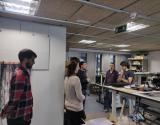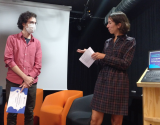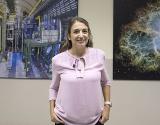Two students of the Astrophysics, Particle Physics and Cosmology masters of the Institute of Cosmos Sciences of the UB have been awarded the Sant Jordi Prize 2021 for best Final Thesis by the Institute of Catalan Studies (IEC). Clàudia Soriano’s work on the Higgs boson has received the first prize while Cristina Jiménez’s thesis on stellar spectra has been given the secondary award.
The event was hosted on Friday, April 23, by the Institute of Catalan Studies (IEC) at the courtyard of the Casa de Convalescència. It was presided by the president of the IEC, Joandomènec Ros and some of IEC’s council members.
You can read the abstracts of both theses here:
Author: Clàudia Soriano Guerrero
Thesis: Optimization of a discriminant to find charged Higgs boson in the ATLAS experiment.
Abstract: This work is based on the optimization of the discriminant used in the separation of the H+ boson signal from the rest of the Standard Model processes, corresponding to background noise, detected in proton-proton type collisions at the ATLAS experiment at CERN. Particularly, the thesis describes the production of H+ with a top quark and a bottom quark and their subsequent decay to a top quark and a bottom quark, and it compares this process to the main background channels produced by tt+jet.
We present a brief review of the Standard Model and its limitations to explain H+ production, furthermore, we introduce SUSY models as an alternative explanation for the origin of the boson. We also describe the collisions and detection methods as well as the reconstruction of the associated physical objects produced during the collision. The data used in this thesis does not correspond to actual data but it is rather the result of a simulation of the physical processes, the collision products and of its detection. For this reason we also provide a brief description of the simulation and analysis methods used, specifically the discriminant.
The main goal of the thesis is the study of the behaviour of several invariant masses used to reconstruct the decay chain of H+ and how these are modified by different parameters (normalization, weights and rebinning).
Finally, we check that the use of mass distributions of the weightless type and rebinned are ideal for the computation of the discriminant to experimentally detect the H+ boson using a Kolmogorov-Smirnov test.
Author: Cristina Jiménez Palau
Thesis: Automated classification of stellar spectra.
Abstract: We analyzed the performance of a PCA-based automated classifier of stellar spectra into the MK system, using as benchmark optical spectra from the SDSS-DR15. We found it is possible to account for 99\% of the total variance arising from A, F, G, K, and M stellar spectra with four principal components. The projections of 50.000 good-quality spectra on this 4D space were used to determine the most probable spectral type of test stars in samples of spectra of increasing quality, with which we evaluated the goodness of our classification procedure using a Gaussian and a Top-Hat Kernel.
This award is a recognition to the quality of education at the Physics Faculty of the University of Barcelona and to the excellency of the research carried out at the ICCUB, therefore, congratulations are in order! You can check out the complete list of award-winners here.





